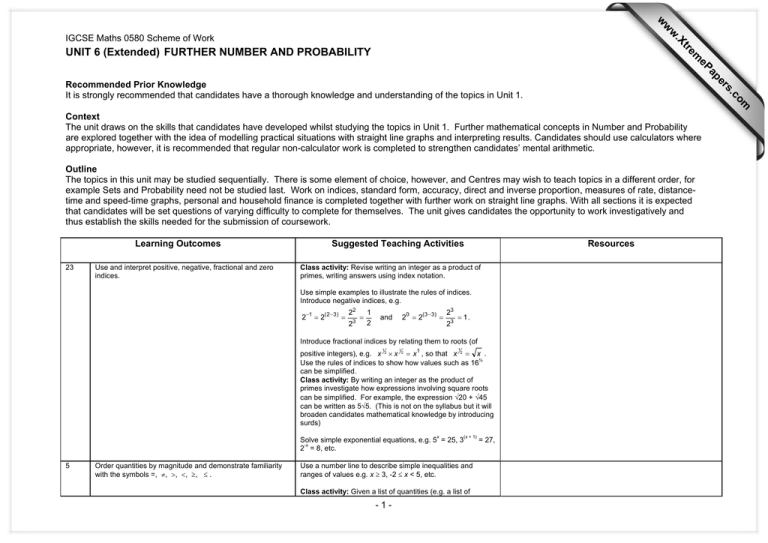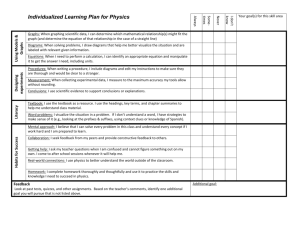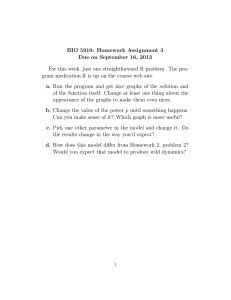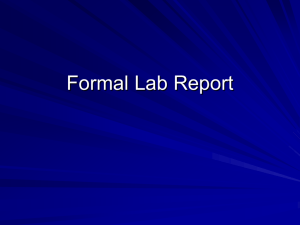UNIT 6 (Extended) FURTHER NUMBER AND PROBABILITY
advertisement

w
w
w
e
tr
.X
IGCSE Maths 0580 Scheme of Work
s
er
ap
eP
m
UNIT 6 (Extended) FURTHER NUMBER AND PROBABILITY
om
.c
Recommended Prior Knowledge
It is strongly recommended that candidates have a thorough knowledge and understanding of the topics in Unit 1.
Context
The unit draws on the skills that candidates have developed whilst studying the topics in Unit 1. Further mathematical concepts in Number and Probability
are explored together with the idea of modelling practical situations with straight line graphs and interpreting results. Candidates should use calculators where
appropriate, however, it is recommended that regular non-calculator work is completed to strengthen candidates’ mental arithmetic.
Outline
The topics in this unit may be studied sequentially. There is some element of choice, however, and Centres may wish to teach topics in a different order, for
example Sets and Probability need not be studied last. Work on indices, standard form, accuracy, direct and inverse proportion, measures of rate, distancetime and speed-time graphs, personal and household finance is completed together with further work on straight line graphs. With all sections it is expected
that candidates will be set questions of varying difficulty to complete for themselves. The unit gives candidates the opportunity to work investigatively and
thus establish the skills needed for the submission of coursework.
Learning Outcomes
23
Use and interpret positive, negative, fractional and zero
indices.
Suggested Teaching Activities
Resources
Class activity: Revise writing an integer as a product of
primes, writing answers using index notation.
Use simple examples to illustrate the rules of indices.
Introduce negative indices, e.g.
2−1 = 2( 2 −3 ) =
22
3
2
=
1
2
20 = 2(3 − 3) =
and
23
23
= 1.
Introduce fractional indices by relating them to roots (of
1
positive integers), e.g. x 2 × x 2 = x 1 , so that x 2 = x .
¾
Use the rules of indices to show how values such as 16
can be simplified.
Class activity: By writing an integer as the product of
primes investigate how expressions involving square roots
can be simplified. For example, the expression √20 + √45
can be written as 5√5. (This is not on the syllabus but it will
broaden candidates mathematical knowledge by introducing
surds)
1
1
x
(x + 1)
Solve simple exponential equations, e.g. 5 = 25, 3
-x
2 = 8, etc.
5
Order quantities by magnitude and demonstrate familiarity
with the symbols =, ≠, >, <, ≥, ≤ .
Use a number line to describe simple inequalities and
ranges of values e.g. x ≥ 3, -2 ≤ x < 5, etc.
Class activity: Given a list of quantities (e.g. a list of
-1-
= 27,
IGCSE Maths 0580 Scheme of Work
n
6
Use the standard form A x 10 where n is a positive or
negative integer, and 1≤ A < 10.
13
Use current units of mass, length, area, volume, and
capacity in practical situations and express quantities in
terms of larger or smaller units.
fractions and decimals) order them by magnitude using
inequality signs.
Use a range of examples to show how to write numbers in
standard form and vice-versa.
Class activity: Use the four rules of calculation with
numbers in standard form.
Use practical examples to illustrate how to convert between:
millimetres, centimetres, metres and kilometres; grams,
kilograms and tonnes; millilitres, centilitres and litres. Use
standard form where appropriate.
Revise rounding numbers to the nearest 10, 100, 1000, etc.,
or to a set number of decimal places. Explain carefully how
to round a number to a given number of significant figures.
8
Make estimates of numbers, quantities and lengths, give
approximations to specified numbers of significant figures
and decimal places and round off answers to reasonable
accuracy in the context of a given problem.
12
Use an electronic calculator efficiently; apply appropriate
checks of accuracy.
9
Give appropriate upper and lower bounds for data given to a
specified accuracy (e.g. measured lengths).
Use straightforward examples to determine upper and lower
bounds for data. For example, a length, l, measured as 3cm
to the nearest millimetre has lower bound 2.95cm and upper
bound 3.05cm. Show how this information can be written
using inequality signs e.g. 2.95cm ≤ l < 3.05cm.
Class activity: Investigate upper and lower bounds for
quantities calculated from given formulae by specifying the
accuracy of the input data.
10
Demonstrate an understanding of the elementary ideas and
notion of ratio direct and inverse proportion; divide a quantity
in a given ratio
Draw a graph to determine whether two quantities (y and x
or y and x2, etc.) are in proportion.
Express direct and inverse variation in algebraic terms and
use this form of expression to find unknown quantities;
increase and decrease a quantity by a given ratio.
Use rounding to 1sf or 2sf to estimate the answer to a
calculation. Check answers with a calculator.
Class activity: Investigate the percentage error produced
by rounding in calculations using addition/subtraction and
multiplication/division. (Percentage error will need to be
discussed beforehand)
Solve problems involving direct or inverse proportion using
the notation y ∝ x ⇒ y = kx and y ∝ 1/x ⇒ y = k/x , where
k is a constant.
Use straightforward examples to illustrate how a quantity
can be increased or decreased in a given ratio, e.g.
enlarging a photograph. The idea of similar shapes can be
introduced here.
Class activity: Investigate the ratio of the length of one side
of an A5 sheet of paper to that of the corresponding side of
an A4 sheet of paper.
Demonstrate an understanding of common measures of
rate; use scales in practical situations, calculate average
speed.
Draw and use straight line graphs to convert between
different units e.g. between metric and imperial units or
between different currencies.
-2-
Revision of estimating and rounding at
http://www.math.com/school/subject1/lessons/S1U1L3GL.html
IGCSE Maths 0580 Scheme of Work
15
Calculate using money and convert from one currency to
another.
Solve straightforward problems involving exchange rates.
Up to date information from a daily newspaper is useful
19
Calculate the gradient of a straight line from the coordinates
of two points on it; calculate the length and the coordinates
of the midpoint of a straight line segment from the
coordinates of its end points; interpret and obtain the
equation of a straight line graph in the form y = mx + c .
determine the equation of a straight line parallel to a given
line
Class activity: Revise drawing a graph of y = mx + c from a
table of values.
demonstrate famililiarity with cartesian co-ordinates in two
dimensions, Interpret and use graphs in practical situations
including travel graphs and conversion graphs, draw graphs
from given data.
Introduce the formula relating speed, distance and time.
Solve simple numerical problems (which should involve
converting between units e.g. find speed in m/s given
distance in kilometres and time in hours).
Apply the idea of rate of change to easy kinematics involving
distance-time and speed-time graphs, acceleration and
deceleration; calculate distance travelled as area under a
linear speed-time graph.
Solve straightforward problems using compound measures
e.g. problems involving rate of flow.
17
Exchange rates can be found at
http://cnnfn.cnn.com/markets/currencies/
Starting with a straight line graph show how its equation
(y = mx + c) can be obtained.
Using examples which illustrate both positive and negative
gradients, show how to calculate the gradient of a straight
line given only the coordinates of two points on it.
Information on speed, distance and time at
http://www.mathforum.org/dr.math/faq/faq.distance.html
Draw and use distance-time graphs to calculate average
speed (link to calculating gradients in Unit 1). Interpret
information shown in travel graphs. Draw travel graphs from
given data.
Class activity: Draw a travel graph for the journey to and
from school. Answer a set of questions about the journey,
e.g. what is the average speed on the journey to school?
Revise how to calculate the area of a rectangle and the area
of a right angled triangle [Further work on this is completed
in Unit 4].
Draw and use speed-time graphs to calculate acceleration
and deceleration. Use straightforward examples to show
that the area under a linear speed-time graph is equivalent
to the distance travelled.
16
Use given data to solve problems on personal and
household finance involving earnings, simple interest and
compound interest, discount, profit and loss; extract data
from tables and charts.
Solve simple problems using practical examples where
possible, taking information from published tables or
advertisements. (It is worth introducing a range of simple
words and concepts here to describe different aspects of
finance, e.g. tax, percentage profit, deposit, loan, etc.)
Use the formula Ι = PRT to solve a variety of problems
involving simple interest.
Class activity: Use newspapers to research the cost of
borrowing money from different banks (or money lenders).
-3-
Information about interest rates can be found from most banks.
They usually have their own web site in the format
http://www.bank name.com/
IGCSE Maths 0580 Scheme of Work
11
1
Carry out calculations involving reverse percentages, e.g.
finding the cost price given the selling price and the
percentage profit.
Revise: Work covered on percentages in Unit 1.
Use language, notation and Venn diagrams to describe sets
and represent relationships between sets as follows:
Revise: Properties of numbers covered in Unit 1.
Give examples from work already covered to illustrate the
language and notation of sets. Distinguish between a
subset and a proper subset.
Definition of sets, e.g.
A = {x: x is a natural number}
B = {(x,y): y = mx + c}
C = {x: a ≤ x ≤ b}
D = {a, b, c, .....}
Notation:
number of elements in set A
“.... is an element of ....”
“.... is not an element of ....”
Complement of the set A
The empty set
Universal set
A is a subset of B
A is a proper subset of B
A is not a subset of B
A is not a proper subset of B
Union of A and B
Intersection of A and B
34
Use simple examples to show how to calculate the original
value of something before a percentage increase or
decrease took place.
Information and references to activities for teachers at
http://www.mathworld.wolfram.com/VennDiagram.html
Draw Venn diagrams and shade the regions which
represent the sets A ∪ B, A ∩ B, A' ∪ B, A ∪ B', A' ∩ B, A ∩
B', A' ∪ B' and A' ∩ B' . Show that (A ∪ B) ' is the same as
A' ∩ B' and that (A ∩ B) ' is the same as A' ∪ B' .
n(A)
∈
∉
A'
∅
ξ
A⊆ B
A⊂ B
A⊆ B
A⊄ B
A∪B
A∩B
Calculate the probability of simple combined events, using
possibility diagrams and tree diagrams where appropriate (in
possibility diagrams outcomes will be represented by points
on a grid and in tree diagrams outcomes will be written at
the end of branches and probabilities by the side of the
branches).
Use Venn diagrams to solve problems involving sets.
Revise: Simple probabilities covered in Unit 1.
Use simple examples to illustrate how possibility diagrams
and tree diagrams can help to organise data.
Use possibility diagrams and tree diagrams to help calculate
probabilities of simple combined events, paying particular
attention to how diagrams are labelled.
Solve straightforward problems involving independent and
dependent events, e.g. picking counters from a bag with and
without replacement.
-4-
Various problems involving probability at
http://nrich.maths.org/public/leg.php





